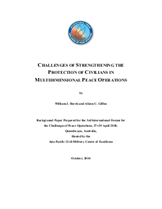BACKGROUND PAPER Challenges of Strengthening the Protection of Civilians in Multidimensional Peace Operations

There is growing consensus, in the United Nations (UN) Security Council and the General Assembly’s Special Committee on Peacekeeping Operations, that UN peacekeeping operations must address Protection of Civilians (POC) and that peacebuilding initiatives must include POC as a cross-cutting issue. Communities where peacekeepers are deployed expect them to be proactive in POC, so their ability to protect directly affects their credibility and legitimacy and thus the mission’s ability to reach its overarching goals. The question is no longer whether to protect but how.
Efforts over the last year to identify ‘how’, including the Department of Peacekeeping Operations and Department of Field Support (DPKO/DFS) New Horizon non-paper, July 2009; the DPKO- and Office for the Coordination of Humanitarian Affairs (OCHA)-commissioned independent study, Protecting Civilians in the Context of UN Peacekeeping Operations: Successes, Setbacks and Remaining Challenges, November 2009; UNSC Resolution 1894, November 2009; the DPKO/DFS Draft Operational Concept on POC, January 2010; and the March 2010 report of the Special Committee, all contribute to the momentum for change.
This paper builds on these efforts and others within and beyond the United Nations system to give participants in the 3rd International Challenges of Peace Operations Forum an up to date assessment of progress on POC in UN peacekeeping operations from an array of normative and operational perspectives. It offers observations and recommendations aimed at making POC in UN peacekeeping more effective.
Designed to follow the structure of the Annual Forum in Australia 2010 ‘Challenges of Protecting Civilians in Multidimensional Peace Operations’, Part I addresses the UN strategic level and Part II strategic humanitarian and regional perspectives. Part III moves to the operational level of UN peacekeeping operations, and Part IV examines the particular roles and requirements in POC of the uniformed components of these operations (military and police). Part V addresses civilian POC stakeholders, with emphasis on conflict prevention and human rights, and Part VI addresses the importance of the rule of law for POC.

